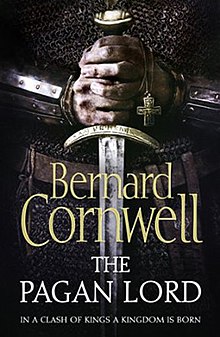The Pagan Lord

First edition cover
|
|
| Author | Bernard Cornwell |
|---|---|
| Cover artist | Jarrod Taylor |
| Country | United Kingdom |
| Language | English |
| Series | The Saxon Stories |
| Genre | Historical novel |
| Publisher | HarperCollins |
|
Publication date
|
2013 |
| Media type | Print (hardback) |
| Pages | 303 pp (hardback edition) |
| ISBN | (hardback edition) |
| Preceded by | Death of Kings |
| Followed by | The Empty Throne |
The Pagan Lord is the seventh historical novel in the Saxon Stories by Bernard Cornwell, first published in 2013. The story is set in the early 10th century in Anglo-Saxon Mercia and Northumbria.
Ten years of relative peace have passed since Alfred died. That is long enough for the Danes. Saxon warlord Uhtred of Bebbanburg tries again to gain his own inheritance and again fights for the kingdoms of Mercia and Wessex, now with his grown son as part of his warrior band.
The novel is written as a first person narrative told by Uhtred as a reflection from his old age. The novel was also published with a family tree of Alfred the Great, a historical note, a list of Anglo-Saxon place names and their modern-day equivalent and a map depicting Anglo-Saxon and Danish Britain including the rivers and places mentioned in the novel.
There have been ten years of relative peace on the island of Britain, between the Saxons and the Danes. Wessex and Mercia are the strongholds of the Saxons, under King Edward, son of the late King Alfred. Uhtred's children have grown, the youngest son is 19. He is trained for war by practice, but never in a shield wall, because there were no battles.
Uhtred rides to disown his elder son Uhtred, who has just taken vows to be a Christian priest. He renames his elder son as Judas, and then bestows the name Uhtred Uhtredson on his younger son, born Osbert and now 19 years old. Abbot Wihtred strikes at Uhtred, always a mistake. Uhtred grabs the staff and strikes Whitred dead. This killing was unintentional. The Christian clerics condemn him so fiercely that the Christians among his band of warriors cannot follow him. Aethelflaed takes these men into her service.
Reaching home, Uhtred sees his hall burning. His woman is taken. Cnut Longsword burnt the hall in retaliation for Uhtred having taken his wife and children. But Uhtred did not do this. The two meet at Cnut’s hall to settle, in Haesten’s presence, two Danish jarls. Returning home, Uhtred finds all the outbuildings burnt, this time by Bishop Wulfheard. He has nothing to rebuild and a shrunken force. He decides to reclaim his inheritance, the fortress at Bebbanburg in Northumbria, held by his uncle. He purchases a ship to sail there. Aelfric stole the fortress from Uhtred after Uhtred’s father was killed by the Danes forty years earlier. His uncle had tried and failed to kill Uhtred; then he had him sold into slavery. They reach Bebbanburg, succeeding in entering past the first gate. While Uhtred confronts his cousin, also named Uhtred, Finan slips into the smithy coming out with cousin Uhtred’s wife Ingulfrid, 11-year-old son (also Uhtred), and the hated uncle. Uhtred kills his uncle and leaves with the wife and son of his cousin. They sail out to Frisia to rest and refit.
...
Wikipedia
